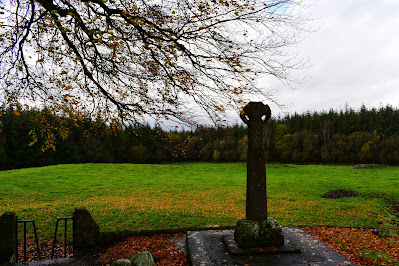Labbacallee Wedge Tomb
Labbacallee Wedge Tomb lies between Fermoy and Glanworth in County Cork. It is believed to be the largest Wedge Tomb in Ireland.
Wedge Tombs are megalithic funerary monuments which date from the early Bronze age around 2500 BCE. They were built during the transitionary period between the late Neolithic Stone age and the early Bronze age around 4500 years ago.
In common with other types of megalithic monuments such as Portal Dolmens and Passage Tombs they were used throughout antiquity and remains and artifacts from later periods have sometimes been found inside them.
The tombs get their name from the distinctive wedge shape they form and they slope downwards from front to back.
Labbacallee Wedge Tomb is a perfect example of the type and because so much of the structure is still intact it is easy to see the wedge shape of the burial tomb. Labbacalle translates into English literally as "The Hags Bed".
There are hundreds of Wedge Tombs in Ireland with some in better condition than others. A lot of the tombs are in inaccessable or remote areas.
Labbacalle is right by the roadside with easy access. Most of these tomb types are located in the western and southern areas of Ireland and while there are also some in eastern areas they are to be found in far fewer numbers.
The inside of a Wedge Tomb is usually divided into several smaller chambers. Sometimes this internal division into separate areas can be clearly seen.
At other times the structures are in poor condition or have been altered at a later stage and the separate chambers can't be easily identified by the naked eye.
The sides of Wedge Tombs are supported by rows of large upright stones, orthostats. Most but not all of these tombs use a double wall construction technique along the sides of the tomb.
The roof is covered with huge stones, the capstones. The capstones at Labbacalle are quite big and in a period without modern mechanisation it must have required a considerable effort to place them into position.
One single stone is estimated to weigh at least 10 tonne.
It's interesting to ponder on what system they might have used for construction.
Did they use big wooden levers and rollers, did they have some type of pulley system for hoisting the stones, were Horses or Oxen involved perhaps used to pull the stones or was all the work done by human hand alone?
It's impossible to know and an exercise in pure guesswork.
Wedge Tombs are believed to have been initially covered in two ways.
Cairns of smaller stones were built up over them while in other instances loose earth and mud was piled on top of and around them.
Wedge Tombs which are above ground now stand denuded of their original covering of small stones or clays.
Skeletal remains were excavated at Labbacalle several of which were reburials and the headless skeleton of a woman was also discovered, as were cremated bone fragments. Beaker pottery has also been excavated at the site.
In Ireland at this time it appears that there may have been various burial rituals in practise simultaneously.
This is evidenced by a lot of Bronze age sites containing a mix of unburnt skeletal remnants and cremated remains side by side.
Perhaps social status dictated a particular funerary rite for a given individual but again that's just supposition as it's impossible to know without written records of which there are none.
Similar tombs are found throughout Europe where they are sometimes referred to as Gallery Tombs. They are often distinct from the Irish Wedge Tomb and have very different features.
The Wedge Tombs dotted throughout Ireland were to be the last of the big megalithic monuments that our distant relatives built.
The era of large stone built monuments to the dead was ending.
What began in the Neolithic period culminating in wonderful rock art and huge Passage Tombs lasting for over two thousand years into the Bronze age came to a close with the building of the Wedge Tombs.
There were to be no more large megaliths erected in Ireland again.
We are fortunate to have such a vast collection of different megaliths scattered throughout such a small Island.
Standing testament to millennia of human occupation and the evolution of belief systems and practises they are truly outstanding works of art and artistry.
I am typing this on a high powered Laptop fitted with a modern processor which uses scientific concepts such as quantum tunnelling to operate.
I momentarily think to myself as I tap on the modern keyboard.
Could I direct and oversee the construction of a tomb such as those at Carrowkeel or Loughcrew, tombs which for thousands of years have remained completely dry inside?
I sincerely doubt it. Our forefathers and mothers, from places as far flung as Brittany, Uzbekistan or even the Rift valley could teach us a lot.
Coordinates here :
52°10'26.8"N 8°20'03.9"W
52.174108 - 8.334407
Further reading:
Landscape contexts of Wedge Tombs in the Northwest of Ireland - Kurt D. Springs
Wedge Tombs - Get behind the Muse
Archaeology.ie - Farmers Journal
Survey of the Megalithic Tombs of Ireland Volume 4






















































